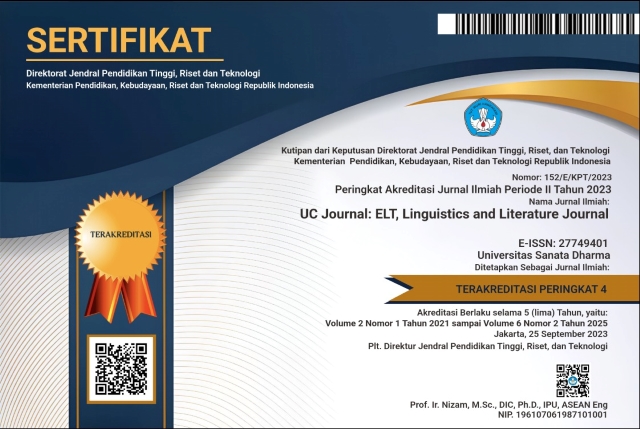PHONOSEMANTICS: PHONEMES OF MODERN GREEK CAN EXPRESS INHERENT MEANINGS?
(1)
(*) Corresponding Author
Abstract
There are four categories of phonological iconicity (sound symbolism or phonosemantics): lexical and non-lexical onomatopoeia (direct phonological iconicity), associative and phonaesthetic iconicity (indirect phonological iconicity). This paper focuses on the third category, the examples of indirect associative phonological iconicity with examples of onomatopoeic words from Modern Greek, which are connected with concepts that refer to acoustic but also to non-acoustic experiences. Indirect, associative connection of consonants and vowels with specific or abstract concepts is based on the phonological characteristics of these phonemes (sonority, manner of articulation, etc.).
Keywords
Full Text:
PDFReferences
Agrawal, P. K. (2020). Psychological Model of Phonosemantics. Journal of
Psycholinguistic Research, 49, 453-474. Retrieved on September 14, 2022, from https://link.springer.com/article/10.1007/s10936-020-09701-y
Ahlner, F. & Zlatev, J. (2010). Cross-modal iconicity: A cognitive semiotic
approach to sound symbolism. Sign Systems Studies, 38 (1/4), 298-348. Retrieved on September 14, 2022, from https://www.pdcnet.org/signsystems/content/Signsystems.
Akita, K. (2011). Toward a phonosemantic definition of iconic words. In P.
Michelucci, O. Fischer & C. Ljungberg (Eds.), Semblance and Signification (pp. 3-18). John Benjamins Puplishing Company.
Butler, R. A. (2017). Cross-Linguistic Phonosemantics. Thesis for a Bachelor of
Arts in IDP Linguistics. The University of Tennessee, Knoxville.
De Cuypere, L. (2008). Limiting the Iconic: From the metatheoretical foundations
to the creative possibilities of iconicity in language. Amsterdam, Philadelphia: John Benjamins Puplishing Company.
Dingemanse, M. & Blasi, D. & Lupyan, G. & Christiansen, M. & Monaghan, P.
(2015). Arbitrariness, Iconicity and Systematicity in Language. Trends in Cognitive Sciences, 19 (10), 603-615. Retrieved on September 14, 2022, from https://www.sciencedirect.com/science/article/abs/pii/S136466131 5001771.
Hiraga, M. K. (1994). Diagrams and Metaphors: Iconic aspects in language.
Journal of Pragmatics, 22, 5-21. doi:10.1016/0378-2166(94)90053-1.
Klamer, M. (2001). Expressives and iconicity in the lexicon. In F. K. Er. Voeltz
& C. Kilian-Hatz (Eds.), Ideophones [Typological Studies in Language 44] (pp. 165-182). Amsterdam: John Benjamins.
LKN. (1998). Dictionary of Standard Modern Greek. Thessaloniki: Institute of
Modern Greek Studies (Manolis Triandaphyllidis Foundation). Aristotle University of Thessaloniki.
Magnus, M. (2001). What’s in a Word? Studies in Phonosemantics. Ph.D. Thesis.
Norwegian University of Science and Technology.
Mannheim, B. (1999). Iconicity. Journal of Linguistic Anthropology, 9 (l-2), 107-
Retrieved on September 14, 2022, from https://www.jstor.org/ stable/43102439.
Masuda, K. (2007). The physical basis for phonological iconicity. In E.
Tabakowska, C. Ljungberg & O. Fischer (Eds.), Insistent Images (pp. 57-71). John Benjamins Publishing Company.
Meier, H. H. (1999). Imagination by Ideophones. In M. Nänny & O. Fischer
(Eds.), From miming meaning: Iconicity in language and literature (pp. 135-154). John Benjamins Publishing Company.
Mpampiniotis, G. (2012). Dictionary of Modern Greek. Athens: Lexicology
Center.
Nasikan, Z. (2019). Phonosemantics: Ongoing Issues and Modern Perpsectives.
Science and Education a New Dimension: Philology, 7 (56), 36-39. Retrieved on September 14, 2022, from https://seanewdim.com.
Perniss, P. & Vigliocco, G. (2014). The bridge of iconicity: from a world of
experience to the experience of language. Philosophical Transactions of the Royal Society B, 369 (1651), 1-13. doi: 10.1098/rstb.2013.0300.
Radden, G. & Dirven, R. (2007). Cognitive English Grammar. Amsterdam,
Philadelphia: John Benjamins Publishing Company.
Sadowski, P. (2001). The sound as an echo to the sense. The iconicity of English
gl- words. In O. Fischer & M. Nänny (Eds.), The motivated sign: Iconicity in language and literature 2 (pp. 69-88). Amsterdam, Philadelphia: John Benjamins.
Sapir, E. (1929). A study in phonetic symbolism. Journal of experimental
psychology, 12, 225-239. Retrieved on September 14, 2022, from https://pure.mpg.de/rest/items/ item_2381142_3/component/file_2381141/ content.
Schmidtke, D. & Conrad, M. & Jacobs, A. (2014). Phonological iconicity.
Frontiers in Psychology, 80 (5), 1-6. doi: 10.3389/fpsyg.2014.00080.
Sidhu, D. M. (2019). Explorations of Sound Symbolism and Iconicity. Doctoral
thesis. University of Calgary.
Sidhu, D. M. & Pexman, P. 2018. Five mechanisms of sound symbolic
association. Psychon Bull Rev, 25, 1619-1643. Retrieved on September 14, 2022, from https://link.springer.com/article/10.3758/s13423-017-1361-1.
Tegopoulos-Fitrakis. (2004). Greek Dictionary. Athens: Armonia.
Tilikidou, E. (2021). Idioms: cognitive, typological, diachronic study. PhD Thesis. Aristotle University of Thessaloniki.
Wayland, R. (1996). Lao expressives. Monkhmer Studies, 26, 217-231.
doi: 10.15144/MKSJ-26.217
DOI: https://doi.org/10.24071/uc.v3i2.5152
Refbacks
- There are currently no refbacks.
Copyright (c) 2022 Elpida Tilikidou

This work is licensed under a Creative Commons Attribution-ShareAlike 4.0 International License.
UC Journal is indexed in:
UC Journal Sinta 4 Certificate (S4 = Level 4)
We would like to inform you that UC Journal: ELT, Linguistics and Literature Journal, or UC Journal has been nationally accredited Sinta 4 by the Ministry of Education, Culture, Research and Technology of the Republic of Indonesia based on the decree No. Surat Keputusan 152/E/KPT/2023. Validity for 5 years: Vol 2 No 1, 2021 till Vol 6 No 2, 2025
DOI: https://doi.org/10.24071/uc
e-ISSN (validity starting Vol 1, No 2, November 2020): 2774-9401

This work is licensed under CC BY-SA.
Creative Commons Attribution-ShareAlike 4.0 International License
 UC Journal: ELT, Linguistics and Literature Journal, a scientific peer-reviewed journal, was established in 20 May 2020 and is published twice a year, namely in May and November, by the English Language Education Study Programme (S1/Sarjana PBI) in collaboration with the English Education Master's Programme (S2/Magister PBI) of Sanata Dharma University, Yogyakarta, Indonesia.
UC Journal: ELT, Linguistics and Literature Journal, a scientific peer-reviewed journal, was established in 20 May 2020 and is published twice a year, namely in May and November, by the English Language Education Study Programme (S1/Sarjana PBI) in collaboration with the English Education Master's Programme (S2/Magister PBI) of Sanata Dharma University, Yogyakarta, Indonesia.














